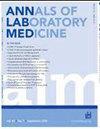Evaluation of Exosome-derived Small RNAs as Potential Biomarkers for Pancreatic Ductal Adenocarcinoma Using Next-generation Sequencing.
IF 3.9
2区 医学
Q1 MEDICAL LABORATORY TECHNOLOGY
引用次数: 0
Abstract
Background Pancreatic ductal adenocarcinoma (PDAC) has a poor prognosis and lacks clinical biomarkers. Exosomes are extracellular vesicles that facilitate cell-cell communication by distributing macromolecules, such as small RNAs (smRNAs). We assessed the potential of exosome-derived small RNAs (Ex-smRNAs) as PDAC biomarkers. Methods Peripheral blood was collected from 51 patients with PDAC and 15 control individuals. Exosomes were isolated using an aqueous two-phase system. Ex-smRNAs were analyzed using smRNA sequencing. smRNA-mediated target gene regulation was verified via The Cancer Genome Atlas analysis and in vitro transfection and wound-healing assays using PDAC organoids. Results The total Ex-smRNA count was substantially reduced in patients with PDAC compared with that in control individuals. The levels of microRNAs (miRNAs) miR-125a-5p, miR-30e-5p, miR-16-2-3p, miR-98-5p, and the let-7 family were significantly suppressed, whereas that of miR-6731-5p was significantly elevated. Let-7c-5p and miR-98-5p were found to interact with the long non-coding RNA OLMALINC to regulate their common target genes, BACH1 and CCND1, thus controlling PDAC proliferation and migration. The expressions of CARS1-AS1 and miR-142-5p were upregulated in treatment-responsive patients. Multivariable Cox regression analyses, adjusting for potential prognostic factors such as sex, Eastern Cooperative Oncology Group performance status, and tumor size and stage, revealed that CARS1-AS1 (adjusted hazard ratio [HR] 0.33; 95% confidence interval [CI], 0.15-0.73; P =0.0061) and miR-142-5p (adjusted HR 0.79; 95% CI, 0.61-1.01; P = 0.0581) were associated with improved overall survival. Conclusions We identified potential Ex-smRNA biomarkers involved in PDAC progression and prognosis that reflect key molecular alterations in PDAC and may serve as clinically relevant biomarkers for disease monitoring.利用新一代测序技术评估外泌体来源的小rna作为胰腺导管腺癌的潜在生物标志物。
胰腺导管腺癌(pancreatic ductal adencarcinoma, PDAC)预后差,缺乏临床生物标志物。外泌体是细胞外囊泡,通过分布大分子如小rna (smrna)来促进细胞间的通讯。我们评估了外泌体衍生小rna (ex - smrna)作为PDAC生物标志物的潜力。方法采集51例PDAC患者和15例对照组的外周血。外泌体采用双水相系统分离。使用smRNA测序分析前smRNA。通过癌症基因组图谱分析、PDAC类器官体外转染和伤口愈合实验,验证了smrna介导的靶基因调控。结果与对照组相比,PDAC患者的总Ex-smRNA计数明显减少。miR-125a-5p、miR-30e-5p、miR-16-2-3p、miR-98-5p和let-7家族的mirna水平被显著抑制,而miR-6731-5p的水平显著升高。Let-7c-5p和miR-98-5p与长链非编码RNA OLMALINC相互作用,调节其共同靶基因BACH1和CCND1,从而控制PDAC的增殖和迁移。在治疗反应性患者中,CARS1-AS1和miR-142-5p的表达上调。多变量Cox回归分析,校正了潜在的预后因素,如性别、东部肿瘤合作组的表现状况、肿瘤大小和分期,显示CARS1-AS1(校正风险比[HR] 0.33; 95%可信区间[CI] 0.15-0.73; P =0.0061)和miR-142-5p(校正风险比[HR] 0.79; 95% CI, 0.61-1.01; P = 0.0581)与总生存率的提高相关。我们发现了参与PDAC进展和预后的潜在Ex-smRNA生物标志物,这些生物标志物反映了PDAC的关键分子改变,可能作为疾病监测的临床相关生物标志物。
本文章由计算机程序翻译,如有差异,请以英文原文为准。
求助全文
约1分钟内获得全文
求助全文
来源期刊

Annals of Laboratory Medicine
MEDICAL LABORATORY TECHNOLOGY-
CiteScore
8.30
自引率
12.20%
发文量
100
审稿时长
6-12 weeks
期刊介绍:
Annals of Laboratory Medicine is the official journal of Korean Society for Laboratory Medicine. The journal title has been recently changed from the Korean Journal of Laboratory Medicine (ISSN, 1598-6535) from the January issue of 2012. The JCR 2017 Impact factor of Ann Lab Med was 1.916.
 求助内容:
求助内容: 应助结果提醒方式:
应助结果提醒方式:


